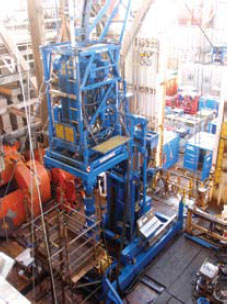Jim Wright, Qserv
The North Sea decommissioning process is gathering momentum. One of the biggest projects underway is the decommissioning of BP’s Miller Field, where well abandonment activity is at an advanced stage.
The mature UK oil industry continues to operate at full capacity, and high utilization rates for personnel and equipment are common. Efficient management of well services is crucial to cost-effective operations. During decommissioning, where production has ceased and there is no return on the field infrastructure operating costs, this efficiency is critical.
INVESTIGATION
BP-operated Miller Field lies 270 km northeast of Aberdeen in the central North Sea. Oil was first discovered in 1982, and production commenced in 1992. Peak production was 150,000 bopd and 225 MMcfgd. The field reached the end of economic production and was shut down in mid-2007.
Well, process and pipeline services company Qserv was employed to provide slickline, coiled tubing and fluid pumping services to execute the required well abandonments on the Miller platform. A pre-abandonment investigation was conducted on each well to determine the tubing integrity. The objective of the work was to confirm which wells could be abandoned by conventional circulation cement jobs through the tree and which had tubing-to-annulus communication, requiring coiled tubing to spot the cement at the required target depths.
Each wellbore was drifted with slickline to confirm access and then suspended with a mechanical bridge plug. The tubing was pressure tested to confirm its integrity, then perforated above the bridge plug, and the annulus was circulated to seawater. An additional pressure test on the tubing and annulus was performed to confirm the integrity of the production packer. The investigation found that seven of the wells required coiled tubing.
FLUID DISPOSAL
Without a full surface fluid-handling package, the platform process system was decommissioned before the start of any well work, and required an alternative means to handle and safely dispose of any circulated wellbore fluids. The installation’s closed drain system was used to securely control any fluids circulated from the wellbore throughout the campaign. However, the vessel’s limited volume was a constraint and required accurate management to avoid impinging on the intervention efficiency.
The company provided a fluid handling and monitoring system, including fluid pumps, tanks and treating iron lines to safely transfer the contents of the closed drain and dispose of any fluid into a disposal well. The system was a permanent fixture on the installation throughout the abandonment campaign and allowed for the well interventions to be executed without any unnecessary delay. It also allowed the platform infrastructure to be disassembled offline to reduce project time.
INTERVENTION MAST
All coiled tubing operations were conducted through the rig floor, but due to the volume of intervention required it was decided to use the service company’s intervention mast to support the injector head, as an alternative to hanging off the traveling block, Fig. 1. Although this required additional pre-job planning to ensure relevant interfaces were captured, it mitigated many hazards normally associated with coiled tubing operations and greatly improved execution efficiency.
 |
|
Fig. 1. Intervention mast on the rig floor.
|
|
The increased functionality of the mast allowed the injector head to be detached from the traveling block and remain rigged up throughout the whole campaign. This reduced the number of lifting operations on the rig floor, and the fine hydraulic control of the mast minimized human intervention when detaching the injector head from the riser. It also allowed the traveling block to be used for supporting the well control stack while skidding between wells without having to rig down the intervention equipment, and allowed the slickline pressure control stack to be rigged up simultaneously to the injector head.
“The first two phases of the Miller well abandonment project have been very successful,” said Colin Smith, Miller well abandonment team lead. “All of the key project challenges have been successfully delivered.”
PERSONNEL
The company recognized the importance of using multiskilled personnel. Slickline, fluid pumping and coiled tubing operations were performed on a daily basis. To have independent specialist crews for each service would not have been cost-effective, so BP committed to a dedicated pool of personnel, each of whom was cross-trained in technical aspects of each service. This cross-training yielded a considerable reduction in personnel costs and also allowed for free personnel capacity to be used by other service providers, ultimately optimizing the project schedule. 
|
THE AUTHOR
|
| |
Jim Wright earned a bachelor’s degree with honors and a master’s degree in mechanical and offshore engineering at the Robert Gordon University. He joined Qserv as an Operations Engineer providing technical support for the company’s coiled tubing and pumping clients. In late 2007 he moved into the business development department.
|
|
| |
|




